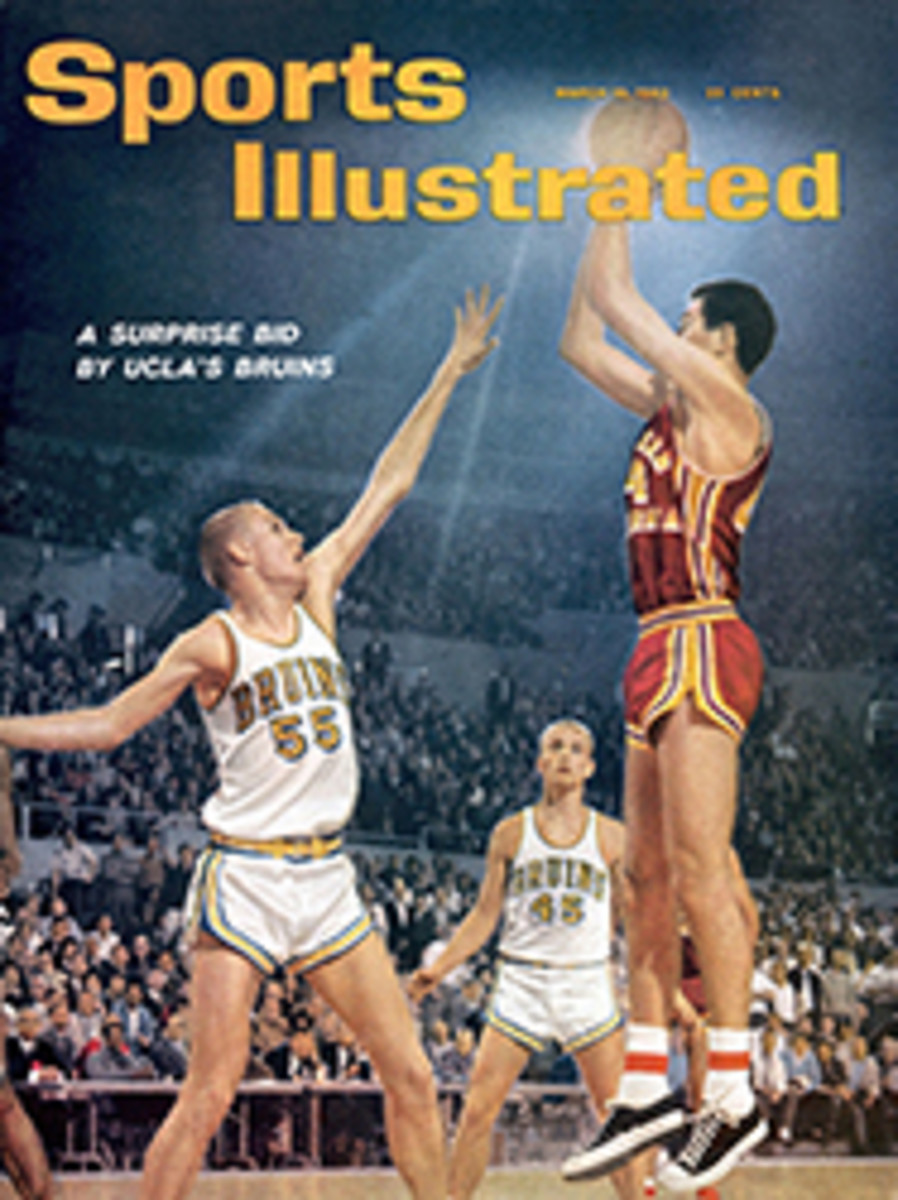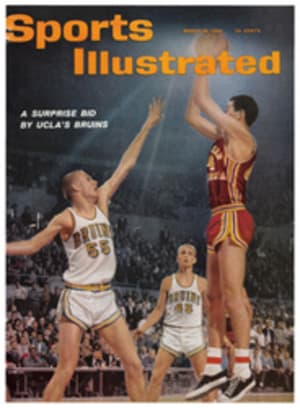
Harvard recruits a hockey player—or does it?
It won't surprise anybody much to learn that the best all-round college hockey player in the U.S. is a Canadian. The surprising fact is that he is playing for Harvard. Hockey has been a high-status sport on the banks of the Charles River ever since 1895, when the Harvard boys called it "ice polo." But Harvard, unlike most U.S. colleges, has for the most part made do with U.S.-born players. The official university attitude—like that of the entire Ivy League—is one of stern disapproval of open recruiting of foreign talent—particularly from Canada's frankly salaried Junior A leagues.
Nevertheless, one of Harvard's best hockey teams in years has just achieved an Ivy League championship with the aid of Gene Kinasewich, of Edmonton, Alberta, who played what amounted to professional hockey in Canada for two years before reaching Cambridge. He came to Harvard, in fact, not expecting to be allowed to play hockey at all.
An orphan with eight brothers and four sisters, a slim financial future and a special skill on skates, Kinasewich as a boy almost took it for granted that he would someday become a professional hockey player. In his sophomore year at Edmonton's Victoria Composite High School he joined the local Junior A league team and scored 25 goals and 20 assists during his first season.
"We got paid," Kinasewich admits. "But no more than other kids in school who had part-time jobs. Those of us who played hockey weren't allowed to take other jobs because it interfered with practice. Actually I made more money in grade 9 working in a grocery store and delivering newspapers than I ever did playing hockey. Maybe our definition of amateurism is different."
Whatever the semantics of the case, by the middle of his junior year in high school Kinasewich had become a star with true major league potential and had been approached by scouts who encouraged him to aim for a professional career. Then in December 1956 he met Jim Lombard, a Boston youth and a self-appointed recruiter who later became Harvard's hockey manager. Lombard, who was already a rabid Harvard fan, made it his business to sell Kinasewich on the virtues of combining hockey with a Harvard education, then, with the help of some Harvard alumni, figured out a way to shoehorn him into the university. Everyone agreed that a vital first step would be to spend a year in a U.S. prep school. To implement this plan, Kinasewich applied for a scholarship at Deerfield Academy in Deerfield, Mass. The school rejected him but suggested that he reapply after taking his senior year at Edmonton. Undaunted, Kinasewich wrote back that he wanted an education much more than a hockey career. However, he pointed out that he could not afford to turn down a pro offer and then be rejected by Deerfield the second time around.
Seemingly impressed with this argument, and with Gene's academic zeal, Deerfield changed its mind. To repay its faith in him, the young scholar thereupon scored 91 points (48 goals and 43 assists) in 16 games for the school's hockey team, won his letters on the soccer field and the baseball diamond and was elected treasurer of his class. In the spring of 1960 he applied for an academic scholarship at Harvard, on the basis of marks and need, and was accepted—with a warning from the dean that he would almost certainly be declared ineligible for the hockey team. "It was hard for me to think of staying four years in college without hockey," says Gene, "but it would have been ridiculous to pass up a Harvard education."
Jackpot for Cooney
The dean's gloomy prediction held true for a year, but at the start of Kinasewich's sophomore season the Ivy League committee on eligibility was persuaded to review his case. Because of the "quality of his academic performance during freshman year" the committee apparently decided that the young man meant what he said about preferring an education and that Harvard had not lured him under false pretenses to play hockey. Since the committee was satisfied that no one concerned cared about hockey, it decided Kinasewich should be allowed to play as a reward. The immediate result was a Harvard hockey season of 20 wins and four losses, and something like a jackpot hit for Harvard Coach Ralph (Cooney) Weiland, a onetime Boston Bruin.
Cooney is a laconic man, but he glows when he discusses Kinasewich. "I know a good Canadian when I see one," Weiland says, "and I don't see many as good as this one. He's got a lot to learn, but he's a natural forward with a defenseman's brains, and he keeps his head up. He's got speed and balance, and he's probably the best shooter I've ever coached."
Reared in the wide-open Canadian style, Harvard's young star has found it hard to adapt to the more cautious collegiate game of position and team hockey. "Back home I was taught to break for the goal the moment we got the puck," he explains. "My center could always dump the puck on my stick. I never had to hold back."
The halfback
This strategy didn't work at Harvard. At the beginning of the season the new wingman was shaking loose on every rush, but his line could never keep up with him. Weiland broke his frisky colt by switching him to center. "It's calmed him down and he's learned how to control the puck better," says Weiland. As a playmaking center Kinasewich himself scored fewer goals, but with his help his teammates began scoring many more. His right wingman, Tim Taylor, a junior from South Natick, Mass., has converted enough Kinasewich passes into goals to become a top individual scorer in his own right. Before Kinasewich came, Taylor had only one goal and 6 assists in 20 games. Though most spectacular on a freewheeling sortie down ice with the puck, Kinasewich is just as effective on defense as he is on offense. At center ice he often skates in lazy circles, waiting like a vulture for the opportune moment to dart in and flick the puck away from an oncoming forward attacker with a deft movement of his stick. If Kinasewich has a fault at all, according to Cooney Weiland, it is his nonchalant habit of holding his stick in one hand when he takes the puck. The other hand is used to fend off defensemen. Growls Weiland: "Hell, you'd think he was a halfback."
"I'd like to give Kinasewich his head," moans the Harvard coach, "and he could score more goals if I did. But it's too risky when you've got one outstanding Canadian and an average bunch of American players."
PHOTO
HARVARD'S CANADIAN BREAKS AWAY FROM TWO DETERMINED PRINCETON DEFENDERS

